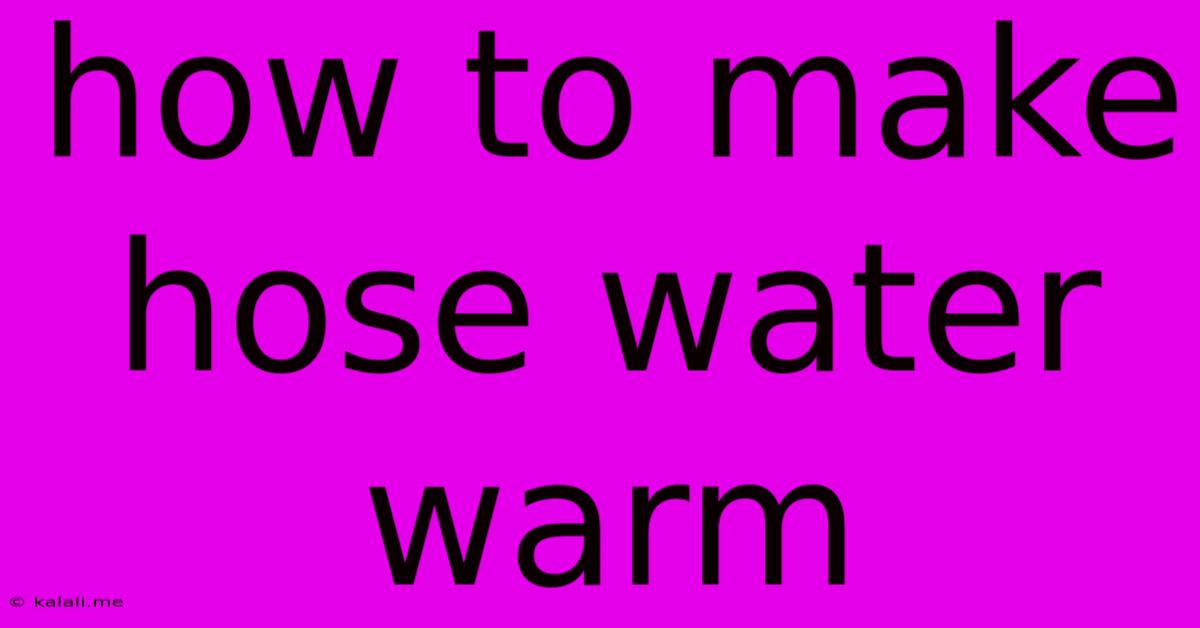How To Make Hose Water Warm
Kalali
May 25, 2025 · 3 min read

Table of Contents
How to Make Hose Water Warm: A Guide to Backyard Comfort
Getting that perfect temperature for outdoor tasks like washing your car, watering delicate plants, or even a refreshing outdoor shower can be tricky with cold hose water. This article explores several methods to achieve pleasantly warm water from your garden hose, eliminating the chill and enhancing your outdoor experience. We'll cover DIY solutions and commercially available options, helping you find the perfect fit for your needs and budget.
Understanding the Challenge: Why is Hose Water Cold?
Before diving into solutions, it's important to understand why hose water is typically cold. The water in your garden hose comes directly from your home's main water supply, which is usually sourced from underground reservoirs. This water is naturally cool, especially during colder months, and isn't heated like the water in your home's plumbing system. Therefore, warming it requires external intervention.
Methods to Warm Your Hose Water
Here are several approaches to achieving warmer hose water, ranging from simple to more involved:
1. The Sun's Natural Heating:
- How it works: This is the simplest and most cost-effective method. Leave a filled black hose or a dark-colored container (like a bucket) in direct sunlight for several hours. The sun's energy will naturally heat the water.
- Pros: Free, eco-friendly, easy to implement.
- Cons: Dependent on weather conditions (sunny and warm days are essential). The temperature increase might be limited. Not ideal for large volumes of water or quick results.
2. Utilizing a Water Heater (Indirect Method):
- How it works: Run your hose water through a separate container filled with pre-heated water. You can use a bucket or large container filled with hot water from your indoor water heater.
- Pros: Relatively quick, achieves a warmer temperature than solar heating.
- Cons: Requires manual effort to fill and refill the container. Less efficient for large volumes of water, and involves potential for spills.
3. In-Line Hose Water Heaters (Commercial Options):
- How it works: These are specialized devices that attach to your hose and use electricity or propane to heat the water as it flows.
- Pros: Provides consistently warm water, suitable for larger volumes.
- Cons: Higher initial cost compared to DIY solutions. Requires a power source (electricity or propane).
4. DIY Solar Water Heater (Advanced Approach):
- How it works: This method involves building a simple solar water heater using black pipes or tubing, a dark-colored container, and insulation. Sunlight heats the water within the pipes, which then flows into your hose.
- Pros: Eco-friendly, relatively inexpensive materials, suitable for larger volumes of water over time.
- Cons: Requires more time, effort and some DIY skills. Effectiveness depends on the design and materials used. Less effective in cloudy weather.
Choosing the Right Method for You
The best method for warming your hose water depends on your specific needs and circumstances:
- For occasional use and small volumes: The sun's natural heating or the indirect method using a pre-heated container might suffice.
- For frequent use and larger volumes: An in-line hose water heater is a more efficient and convenient solution.
- For an eco-friendly and cost-effective long-term solution: Consider building a DIY solar water heater, though it requires more upfront effort.
Remember to always prioritize safety when working with water and electricity. Carefully follow the instructions for any device you use. By considering these options, you can transform your outdoor chores and enjoyment with the simple luxury of warm water.
Latest Posts
Latest Posts
-
Out Of The Mouth Of Babes
May 25, 2025
-
How Do I Hang A Mirror On The Wall
May 25, 2025
-
Why Does My Cat Not Like To Be Held
May 25, 2025
-
Rebellion Is As A Sin Of Witchcraft
May 25, 2025
-
Rotary Encoder With Detents And Haptic Feedback
May 25, 2025
Related Post
Thank you for visiting our website which covers about How To Make Hose Water Warm . We hope the information provided has been useful to you. Feel free to contact us if you have any questions or need further assistance. See you next time and don't miss to bookmark.